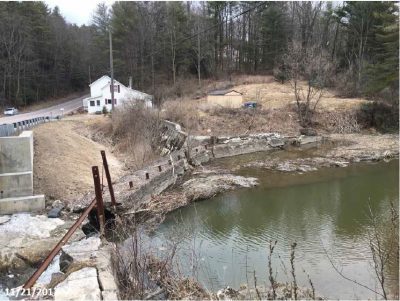August 21, 2018 (Montpelier, VT) – The Vermont Natural Resources Council (VNRC) has completed a feasibility study and preliminary engineering for removal of the Mill Pond Dam on Indian Brook in Colchester. The study was funded by a $35,000 Ecosystem Restoration Grant from the Vermont Department of Environmental Conservation, Clean Water Initiative Program.
Dams have existed on Indian Brook since the early 19thcentury to provide power for a series of sawmills, but the Mill Pond Dam has not served a purpose since the last mill burned down in 1941. Meanwhile, its impoundment has eliminated 2,200 feet of free-flowing riverine habitat, which is now choked with sediment carried from upstream. In addition, the deteriorating dam is classified by the state Dam Safety Program as “significant hazard,” meaning there is potential for loss of life and “appreciable” economic loss should the dam fail.
VNRC is working with the owner of Mill Pond Dam and project partner The Nature Conservancy to restore the surrounding stream to a more natural condition, eliminate the public safety hazard posed by the deteriorating dam, and relieve the owner of a financial and legal liability. Much of the dam’s sediment will be removed as well to prevent it from being carried downstream and into Mallets Bay, which will remove an estimated 14 tons of phosphorus from the ecosystem.
“Vermont has more than 800 known dams, and we estimate that hundreds of them may serve no useful purpose. Instead, they degrade water quality and aquatic habitat, restrict the movement of fish and other wildlife, and pose risks to public safety,” said B.T. Fitzgerald, Dam Project & Vermont Dam Task Force Coordinator at VNRC. “A big part of our work at VNRC is helping owners who want to remove unwanted dams, which can have lasting benefits for entire communities and ecosystems.”
With the preliminary work on Mill Pond Dam now complete, VNRC has secured funding to complete the design and obtain the necessary federal, state and local permits, and is seeking funding to remove the dam and sediment and restore the natural habitat of the stream. If funding can be obtained, removal could take place in 2019.
For more information about the work VNRC and its partner organizations are doing to remove “deadbeat” dams across Vermont, visit http://freevtrivers.org.
###




